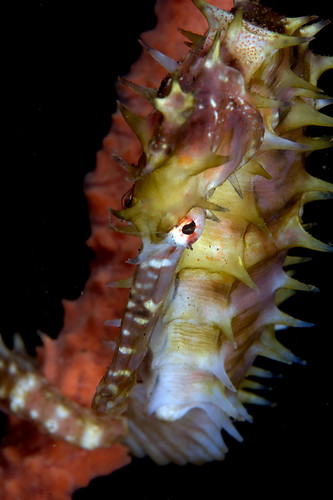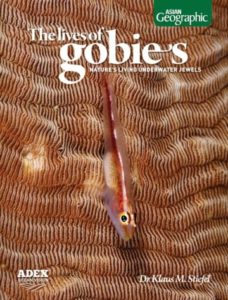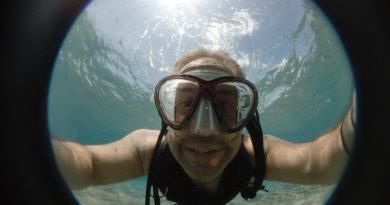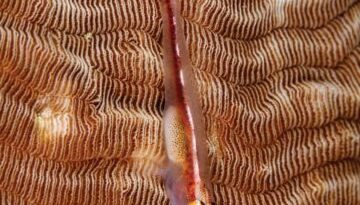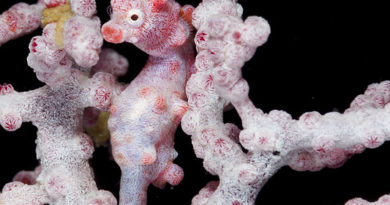Anthropomorphizing in Ecotourism
I have recently written a blog about the fact that flash photography, according to two well-done scientific studies, does not harm the eyes, or modify the behavior of seahorses, frogfishes and ghost pipefishes.
Below is the full post. The science is pretty clear on this, and it’s worth explaining to a general audience, since many scuba diver are under the impression that strobing small critters is akin to death by shock for them:
The Response
The responses I got on social media to this post were very interesting. Some people were quite set in their ways. they probably hadn’t read the blog post, with all the relevant science easily understandably digested, explained in layperson’s terms. They did not approach the issue wanting to learn, but told me that they don’t use strobes because they are definitely bas for small marine animals, as anyone knows.
But besides that there were some genuine, well-intentioned responses. A common argument was “don’t do to others what you don’t want done to you”, which is a good principle when dealing with other humans. Respect for animals in the wild is a great thing, and in general the world has too little of it, not too much. But this is still a case of science denialism, wrongful anthropomorphizing and mistaken conservation priorities.
What these well-intentioned scuba divers miss is that the seahorse eye and visual brain are very different from that of humans.; and that even if something sounds “reasonable” and “common sensical” to you, there is no substitute for systematically studying the issue before forming a strong opinion on it; and that such niche problems are not irrelevant, but can cloud the view of the bigger picture.
Bony Fish and Mammals are Very Distantly Related
Bony fishes, to which the seahorses belong, and our ancestors probably split some time in the early Devonian period, around 419 million years ago. The seahorses and us are both vertebrates, but of very different types, with only very ancient shared ancestry. The lens of the fish eye is quite distinct from the mammalian eye, especially in the way it can change shape to accommodate different optical needs for seeing near or far. The circuits in the fish retina behind the eye are related, but not identical at all to the human retina (the goldfish retina is very well studied). Most importantly, the brain of bony fishes is very different in its outline than that of mammals, starting with a topologically completely different folding very early in embryonal development. The massive difference in brain size also makes a difference, of course. The processing of visual (light) information in our brains and in those of fishes works in ways quite unlike each other.
So, if you as a human “don’t like to be flashed in your face”, this might have to do very little to do with the experience of a seahorse. Your “not liking” depends on your eyes and brain, which are very different from those of a fish. This is the case even for cute looking fishe like pink pygmy seahorses. What I packed in the last paragraph is a lot of evolutionary biology and neuroscience, and I realize that taking this in via one blog post is not easy. I do hope that the basic message comes across to some of my audience.
Anthropomorphizing a wild animal makes limited sense when observing mammals or even primates, much closer evolutionary cousins to us. These will share some anatomical, behavioral and physiological workings with us. When it comes to fish, the parallels between them and us are much less.
Often this acts against fishes – the lack of human-like facial expressions make people think they lack emotions and a rich inner life and feel no pain (but see this!). As a consequence, many people feel nothing when killing and abusing fish. Different does not mean less; the fish eye and brain don’t operate like the human eye and brain, but that does not mean that fish don’t have some amount of sentience.
Add Ecotourism
For the most part I believe ecotourism is an excellent part of any economy. People make a living off nature without consuming it. Tourists pay for intact nature, generating an intention to keep nature intact. Yes, there can be problems, when ecotourism sites are poorly managed or when the crowds grow too large, but these are often problems of implementation, not problems with ecotourism in principle. I have seen positive effects of ecotourism in affluent countries (my home country, Austria, with its beautiful Alps), and in middle/low income countries, like my adopted home country, the Philippines. The marine protected areas in Dauin/Negros Island are full of intact corals and fish, some of them big fish, which is certainly also due to the thriving scuba tourism in the area (hopefully coming back soon as of December 2021…).
A taste of diving in Dauin, a popular scuba diving/ecotourism location:
In ecotourism, the misunderstanding of animals, especially of non-mammalian animals, works the other way around. The ecotourist doesn’t want to kill and eat an animal (and hence would be inclined to downplay its inner lives), but he or she wants to appreciate the animal, and hence tends to put himself into the animal’s shoes. The attitude, of empathy towards animals, is much preferred of course. But too much anthropomorphizing can lead to funny outcomes.
The ecotourist wants to preserve what he or she has come to appreciate, and wants to avoid stress to the animals he or she has come to see and photograph. An example of this is the wish to avoid stressing seahorses by strobe photography. Which doesn’t stress them, however. The – very positive – empathy, paired with a lack of understanding of fish biology has led to an outcome akin to a superstition. “Don’t let a black cat cross the road in front of you” … “Don’t use flash photography on seahorses”. The so-faux-animal-welfare-moved ecotourist makes his life unnecessarily more complicated. A proper ecotourist should try to understand the nature he has come to appreciate better. He or she should be people of education and reason. Silly superstitious beliefs don’t become him.
Layers of Environmental Problems
On top of the inappropriate anthropomorphizing, the overt focus on pet or fake environmental problems like the scaring of critters by photographic strobes shows a slightly miss-aligned view of the present day’s environmental problems.
To me, anthropogenic climate change, anthropogenic ocean acidification and the massive biodiversity loss which we are causing as increasingly numerous humans are the main environmental issues the planet is facing in the 21st century. Climate change and ocean acidification are caused by human CO2 emissions, whereas the biodiversity loss has a large number of human-made causes, such as ecosystem destruction and fragmentation, and overt hunting/poaching.
(In case you are not aware of ocean acidification, here is a brief explainer video):
Then, there is a second layer of serious environmental problems, more local, but still serious and important. These are the destruction of local nature places, such as forests, mangroves, or lakesides. Preventing a massive land reclamation project on top of a coral reef is of great priority, even though it “only” affects one small part of the world. Such cases are serious environmentalist battles which should be fought with all the energy activists can muster. These serious local environmental issues interact with the big questions, as locally human-stressed ecosystems will have a harder time coping with the effects of climate change, ocean acidification (if they are marine) and biodiversity loss.
And Then there Are The Pet And Fake Problems
At the lowest layer reign niche issues, such as the non-frightening of seahorses by strobes or the non-issue of reef-killing sunscreen (there is not nearly enough sunscreen on bathers’ skins to make a difference). These two issues are in fact misunderstandings by a well-meaning public. A related type of problems are those which are real, but minor. Polluting plastic straws are indeed making their way into the ocean; but they constitute less than 1 percent of plastic trash in the ocean. It’s good if a resort phases out single use plastic straws; but it shouldn’t remain at this in regards to their environmental efforts. It’s a good start! Both the non-issues and the minor issues often get a surprising amount of media attention. It’s good that the public in many countries has become more environmentally minded, but the good intentions need to pair up with good education and reflection.
Read the science or believe the scientists. Think global, act local, and keep things in perspective on this Anthropocene Earth.
Coming up soon … if you like my popular science writing, please get yourself a copy of “The Lives of Gobies”, coming out soon with Asian Geographic:
